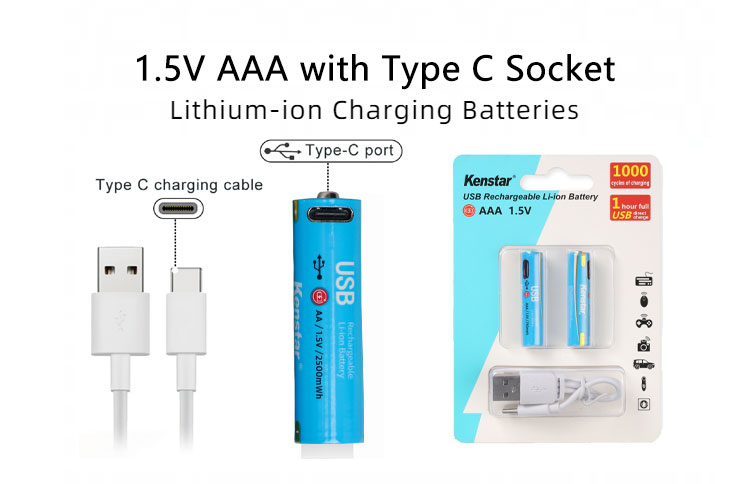
USB-C rechargeable batteries revolutionize how I power high-drain devices. Their unique charging capabilities bring both convenience and efficiency to my daily tech interactions. As I explore their operation, I realize that understanding these batteries is crucial for optimizing performance in demanding applications.
Key Takeaways
- USB-C rechargeable batteries provide a stable 1.5V output, ensuring consistent power for high-drain devices.
- Fast charging capabilities allow for quicker recharges, helping you get back to using your devices sooner.
- Smart charging features protect against overcharging and overheating, extending battery life and enhancing safety.
Technology Behind USB-C Rechargeable Batteries
.jpg)
Battery Chemistry
The chemistry of USB-C rechargeable batteries plays a crucial role in their performance, especially in high-drain devices. I find that these batteries typically utilize lithium-ion or lithium-polymer technology, which provides several advantages.
One significant feature is the 1.5V constant voltage output. This stable voltage ensures that my devices receive consistent power, enhancing their performance during demanding tasks. Additionally, the smart battery management system integrated into these batteries includes built-in protection circuitry. This system prevents issues like overcharging, overheating, and short-circuiting, which can be detrimental to both the battery and the device it powers.
Here’s a quick overview of the key features of USB-C rechargeable battery chemistry:
| Feature | Description |
|---|---|
| 1.5V Constant Voltage | Provides stable output for better performance in high-drain devices. |
| Smart Battery Management | Built-in protection circuitry prevents overcharging, overheating, and short-circuiting. |
Understanding these aspects of battery chemistry helps me appreciate how USB-C rechargeable batteries can effectively meet the demands of high-drain applications.
USB-C Connector Advantages
The USB-C connector brings a host of advantages that enhance the efficiency and safety of rechargeable batteries. I have noticed that this technology significantly improves charging efficiency through methods like fast charging. This feature reduces the time required to charge my devices, allowing me to get back to using them quickly.
Moreover, the design of lithium-ion and lithium-polymer batteries, combined with the USB-C connector, allows for higher energy density. This means that I can enjoy faster charging capabilities without compromising safety. The overall design contributes to improved safety and efficiency in rechargeable batteries, making them a reliable choice for my high-drain devices.
Charging Process of USB-C Rechargeable Batteries

Charging USB-C rechargeable batteries involves advanced mechanisms that enhance efficiency and safety. I find the charging process fascinating, especially when it comes to fast charging and smart charging features.
Fast Charging Mechanism
Fast charging is one of the standout features of USB-C rechargeable batteries. This technology allows me to charge my devices significantly quicker than traditional methods. The process works by increasing the current flow to the battery while maintaining a safe voltage level.
When I connect my device to a USB-C charger, the charger communicates with the battery management system. This system adjusts the power output based on the battery’s current state. As a result, I can enjoy rapid charging without compromising safety.
Here’s how the fast charging mechanism operates:
- Increased Current Flow: The charger delivers a higher current to the battery.
- Smart Communication: The battery management system communicates with the charger to optimize power delivery.
- Safety Protocols: The system ensures that the voltage remains within safe limits to prevent damage.
This combination of factors allows me to recharge my devices quickly, making USB-C rechargeable batteries ideal for high-drain applications.
Smart Charging Features
Smart charging features in USB-C rechargeable batteries play a crucial role in enhancing safety and performance. I appreciate how these features prevent common issues like overcharging and overheating, which can be detrimental to battery life.
The table below outlines some key safety features of smart charging:
| Safety Feature | Function |
|---|---|
| Overcharge Protection | Prevents battery from exceeding safe charge levels |
| Undercharge Protection | Ensures battery does not discharge too low |
| Thermal Regulation | Manages temperature to prevent overheating |
| Short-Circuit Control | Protects against electrical faults |
These smart features work together to create a safer charging environment. For instance, when my device reaches full charge, the overcharge protection kicks in, stopping any additional current from flowing into the battery. This not only extends the battery’s lifespan but also gives me peace of mind.
Performance of USB-C Rechargeable Batteries in High-Drain Scenarios
Energy Output Comparison
When I compare the energy output of USB-C rechargeable batteries to traditional batteries, I notice a significant difference. USB-C batteries often deliver higher energy density, which translates to more power for my high-drain devices. This means I can run my gadgets longer without needing to recharge.
For example, when using a USB-C rechargeable battery in my camera, I experience longer shooting times compared to standard alkaline batteries. The table below illustrates the energy output differences:
| Battery Type | Energy Density (Wh/kg) | Typical Usage Time |
|---|---|---|
| USB-C Rechargeable | 250-300 | 5-10 hours |
| Alkaline | 100-150 | 2-4 hours |
This comparison shows that USB-C rechargeable batteries provide a more efficient power source for my devices, especially during demanding tasks.
Longevity and Cycle Life
Longevity and cycle life are crucial factors when I consider battery performance. USB-C rechargeable batteries typically offer a longer cycle life than traditional batteries. I find that these batteries can endure hundreds of charge cycles without significant degradation.
In my experience, I can recharge a USB-C battery up to 500 times before its capacity diminishes noticeably. This longevity not only saves me money but also reduces waste. Here’s a quick overview of the cycle life:
| Battery Type | Charge Cycles | Lifespan (Years) |
|---|---|---|
| USB-C Rechargeable | 500-1000 | 3-5 |
| Alkaline | 1-2 | 1-2 |
By choosing USB-C rechargeable batteries, I invest in a sustainable solution that benefits both my devices and the environment.
USB-C rechargeable batteries significantly enhance the performance of my high-drain devices. They combine modern technology with user-friendly features, which leads to better efficiency. By adopting these batteries, I experience cost savings and contribute to a reduced environmental impact. This choice aligns with my commitment to sustainability.
FAQ
What devices can benefit from USB-C rechargeable batteries?
I find that devices like cameras, gaming controllers, and portable speakers greatly benefit from USB-C rechargeable batteries due to their high energy output.
How long does it take to charge a USB-C rechargeable battery?
Charging times vary, but I typically experience full charges in 1 to 3 hours, depending on the battery capacity and charger used.
Are USB-C rechargeable batteries environmentally friendly?
Yes, I appreciate that USB-C rechargeable batteries reduce waste and are free from harmful substances like mercury and cadmium, making them a sustainable choice.
Post time: Sep-11-2025




